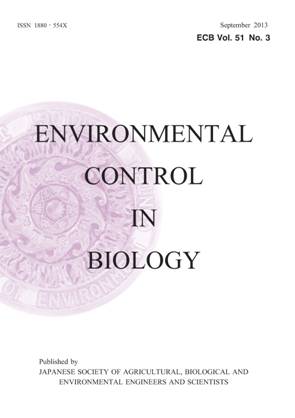Volume 53, Issue 3
Environmental Control in Biology
Displaying 1-10 of 10 articles from this issue
- |<
- <
- 1
- >
- >|
Original Paper
-
2015Volume 53Issue 3 Pages 107-115
Published: 2015
Released on J-STAGE: September 18, 2015
Download PDF (102K) -
2015Volume 53Issue 3 Pages 117-122
Published: 2015
Released on J-STAGE: September 18, 2015
Download PDF (442K) -
2015Volume 53Issue 3 Pages 123-128
Published: 2015
Released on J-STAGE: September 18, 2015
Download PDF (251K) -
2015Volume 53Issue 3 Pages 129-133
Published: 2015
Released on J-STAGE: September 18, 2015
Download PDF (242K) -
2015Volume 53Issue 3 Pages 135-143
Published: 2015
Released on J-STAGE: September 18, 2015
Download PDF (794K) -
2015Volume 53Issue 3 Pages 145-157
Published: 2015
Released on J-STAGE: September 18, 2015
Download PDF (2103K) -
2015Volume 53Issue 3 Pages 159-163
Published: 2015
Released on J-STAGE: September 18, 2015
Download PDF (609K)
Short Communication
-
2015Volume 53Issue 3 Pages 165-167
Published: 2015
Released on J-STAGE: September 18, 2015
Download PDF (99K) -
2015Volume 53Issue 3 Pages 169-173
Published: 2015
Released on J-STAGE: September 18, 2015
Download PDF (439K) -
2015Volume 53Issue 3 Pages 175-179
Published: 2015
Released on J-STAGE: September 18, 2015
Download PDF (689K)
- |<
- <
- 1
- >
- >|
